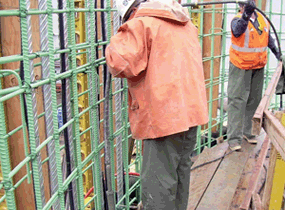By definition, self-consolidating concrete does not require mechanical consolidation. But the problems with SCC are that it is susceptible to segregation, requires more expertise and quality control, can be expensive, and is not always robust (meaning small changes in water content can cause big changes in workability). Even with true SCC (slump flow greater than 18 inches), contractors will sometimes use a little vibration just to make sure the mix is consolidated, especially with congested reinforcing steel. In a properly proportioned mix, this vibration will not lead to separation of the aggregate from the paste (segregation) although there can be some grout leakage at form joints. ‘With slump flows below about 23 inches,” said SCC researcher David Lange, professor at the University of Illinois Champaign, “there may be the need to vibrate just a little bit to help the material move, usually just at the end of the pour when finishing off the top surface.”
The other type of concrete that should be addressed is “high-flow” concrete—this is not quite SCC but is concrete that still flows easily (slump flows between about 14 and 18 inches or even up to 20 inches). This class of concrete is lower priced than 5CC and more robust but still has most of the advantages (rapid placement, fewer workers needed, good finished surfaces). This is a very practical material but it does require some mechanical consolidation (vibration). “If there is access for vibrators then don’t use SCC, but consider “high-flow” concrete,” said Jack Gibbons, technical director for the Concrete Reinforcing Steel Institute, Schaumburg, Ill. “Trump Tower and the Aqua in Chicago are great examples of using 21st century methods without the expense and risk of SCC.”
Proper consolidation is often a judgment call-experienced operators can tell
if they are getting good consolidation by the sound of the vibrator
Related Posts by Categories

No comments:
Post a Comment